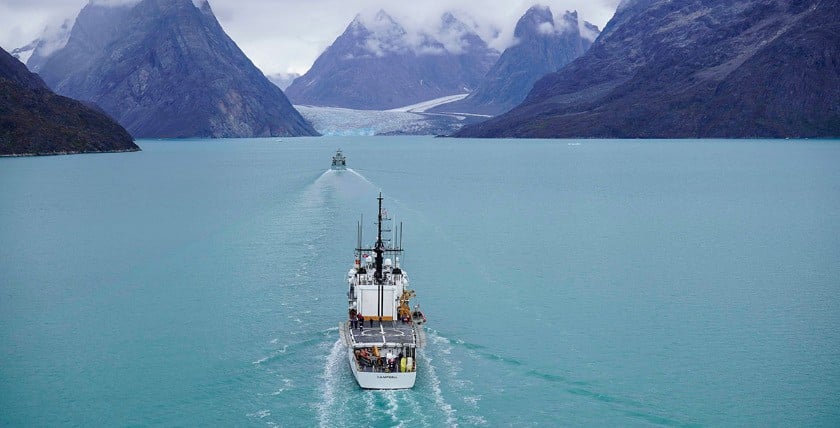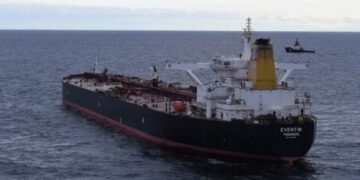After the Cold War, Denmark withheld the necessary resources from its military. The recent crises are now bringing the country closer to the USA again.
Denmark's Prime Minister Mette Frederiksen is always good for a surprise and her invitation to the press conference at short notice with the vague topic of defence met expectations. She announced negotiations with the USA on a possible agreement on security and military cooperation. This wish was communicated to Denmark a year ago, shortly after President Joe Biden took office. The details of the American presence in Denmark still need to be negotiated in the coming months, but the basic objectives can be deduced from the Prime Minister's statements.
The focus of military cooperation will be on the US navy and air force. The deployment of ground troops in peacetime is not being sought and would not be politically feasible. For the US armed forces, it is particularly important to have a high degree of flexibility and to be able to respond quickly to changing security situations. Flying over the airspace or travelling through Danish territorial waters requires notification weeks in advance and this is likely to be an important point in the negotiations. The establishment of depots with ammunition and spare parts at the air bases in Aalborg and Karup and at the naval bases in Korsør and Frederikshavn, as well as rapid refuelling when passing through or flying over, will also be up for discussion. Both can be deduced from Frederiksen's remark that the Danish Agreement will closely follow the Norwegian model. Here, the US Navy and the US Air Force are granted the right to set up their own areas in Norwegian harbours and airfields and to guard them with their own forces. Information about activities is neither given nor demanded. However, the Danish side has emphasised that the ban on nuclear weapons on board ships or aircraft remains in place in peacetime and cannot be negotiated. Storage capacities such as rights of passage are a prerequisite for the US Navy to fly the flag much more frequently in the Baltic Sea in future. By calling at Danish, Polish and certainly also Baltic harbours, it will be able to operate very flexibly. Based on participation in manoeuvres in recent years, it will be Arleigh Burke-class destroyers in particular that will be seen more frequently in the Baltic Sea in future.
From an overarching perspective, the planned Agreement The US is also keen to establish the same framework as the treaties with Norway, Poland, Bulgaria and Romania. The similarity of the agreements for easier administration is just as important for the USA as the fact that its personnel are not subject to national legislation in the event of criminal offences.
Denmark secures the Agreement an additional security guarantee in the knowledge that the country's own armed forces cannot even defend the country for a short time. This is why the break with the policy of the last 70 years is accepted, that foreign troops are only allowed to stay in Denmark for manoeuvres. Disarmament after the end of the Cold War was so extensive that the country is no longer even in a position to deploy the combat brigade promised to NATO for 2024. There is a shortage of ammunition and soldiers. The armed forces' wish list is therefore long and includes, for example, new patrol vessels for the Baltic Sea. A design study was commissioned for this in 2021, but no new units will be commissioned in the short term. Improved equipment for the frigates has been sought for years, but the delivery of SM-2 missiles has been delayed. For reasons of cost, this was initially omitted at the time of commissioning. In this light, it will be inevitable that Denmark will increase its defence spending from the average of 1.3 percent of GDP in recent years to the two percent desired by NATO. The Ukraine crisis, the hasty withdrawal from Afghanistan and the return of the Danish contingent from Mali, which was more of an ejection, should focus politicians' attention on concentrating the country's modest resources on its vital interests in the Baltic Sea region and the Arctic. We must not forget the Russian short-range missiles that have been stationed in Kaliningrad and can reach Denmark within minutes, as well as the approach of Russian fighter jets close to the Danish border, which regularly provokes alarm launches by the Danish air force.
As expected, the Russian government protested against the planned Agreement. Ambassador Vladimir Barbin explained that the negotiations once again emphasised the intention for world domination. In particular, the possible presence of American soldiers on Bornholm would be a thorn in Russia's side. According to the ambassador, even a single soldier would be enough to rethink the relationship between Russia and Denmark, pointing to a treaty that prohibits foreign troops on the island. However, Defence Minister Morten Bødskov rejected this, as it was a sovereign Danish decision. There is no actual treaty prohibiting the stationing of foreign troops, but only an unsigned notation dated 5 March 1946 on the occasion of the withdrawal of Soviet troops from Bornholm. This states that Denmark will resume control and administration of its territory without resorting to foreign troops. During the Cold War, this gentlemen's agreement was honoured, but since 2000, American soldiers as well as those of other NATO countries and Sweden have been on Bornholm for exercises without Russia protesting. The Danish government considers the informal agreement to be invalid, not least for this reason.
The Security agreement will only include Denmark. There has been a treaty for the defence of Greenland since 1951, which was modernised in 2004. Denmark alone is responsible for the defence of the Faroe Islands and the most important presence will be a radar station which, after being decommissioned in 2007, is now to be rebuilt in order to better monitor the GIUK gap between Greenland, Iceland and the northern end of the United Kingdom.
With the Agreement Denmark makes it clear that the USA will remain the most important ally and that European defence cooperation, from which Denmark is excluded by a reservation in its EU membership anyway, will continue to be of secondary importance. As the negotiations are being conducted by a social democratic government and the conservative and liberal parties have signalled their support, parliamentary approval can be regarded as certain. It is difficult to estimate how long it will take to negotiate all the details; observers expect it to take several months.
Andreas Knudsen is a freelance journalist. He lives and works in Copenhagen.
Andreas Knudsen












0 Kommentare